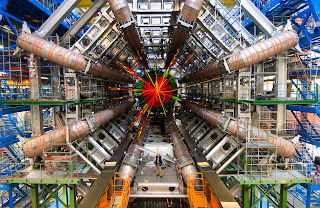We investigate possible signatures of black hole events at the LHC in the hypothesis that such objects will not evaporate completely, but leave a stable remnant. For the purpose of de fining a reference scenario, we have employed the publicly available Monte Carlo generator CHARYBDIS2, in which the remnant's behavior is mostly determined by kinematic constraints and conservation of some quantum numbers, such as the baryon charge. Our fi ndings show that electrically neutral remnants are highly favored and a signifi cantly larger amount of missing transverse momentum is to be expected with respect to the case of complete decay. See: Black Hole Remnants at the LHC by L. Bellagambab, R. Casadioa;by, R. Di Sipioa;bz and V. Viventiax 16 Jan 2012
***
ATLAS Experiment © 2011 CERN "Black Hole" event superimposed over a classic image of the ATLAS detector.
***
If the fundamental Planck scale is of order a TeV, as the case in some extradimensions scenarios, future hadron colliders such as the Large Hadron Collider will be black hole factories. The non-perturbative process of black hole formation and decay by Hawking evaporation gives rise to spectacular events with up to many dozens of relatively hard jets and leptons, with a characteristic ratio of hadronic to leptonic activity of roughly 5:1. The total transverse energy of such events is typically a sizeable fraction of the beam energy. Perturbative hard scattering processes at energies well above the Planck scale are cloaked behind a horizon, thus limiting the ability to probe short distances. The high energy black hole cross section grows with energy at a rate determined by the dimensionality and geometry of the extra dimensions.See: High Energy Colliders as Black Hole Factories: The End of Short Distance Physics
Trackbacks for hep-ph/0106219
- Backreaction: Micro Black Holes [Backreaction @ backreaction.blogspot.com/2006] [trackback posted Fri Sep 22 15:38:00 2006]
- Backreaction: Dangerous Implications? [Backreaction @ backreaction.blogspot.com/2008] [trackback posted Mon Mar 10 19:10:33 2008]
- Hawking radiation - Wikipedia, the free encyclopedia [Wikipedia @ en.wikipedia.org/wiki] [trackback posted Wed May 20 12:44:11 2009]
- Black hole - Wikipedia, the free encyclopedia [Wikipedia @ en.wikipedia.org/wiki] [trackback posted Wed Oct 15 03:57:08 2008]
- Safety of particle collisions at the Large Hadron Collider - Wikipedia, the free encyclopedia [Wikipedia @ en.wikipedia.org/wiki] [trackback posted Sat Feb 21 21:42:47 2009]
- Micro black hole - Wikipedia, the free encyclopedia [Wikipedia @ en.wikipedia.org/wiki] [trackback posted Mon Dec 22 03:02:39 2008]
- Top Cited Articles of All Time (2009 edition) in hep-ph [slac-spires @ www.slac.stanford.edu/spires] [trackback posted Mon Mar 8 05:02:01 2010]









